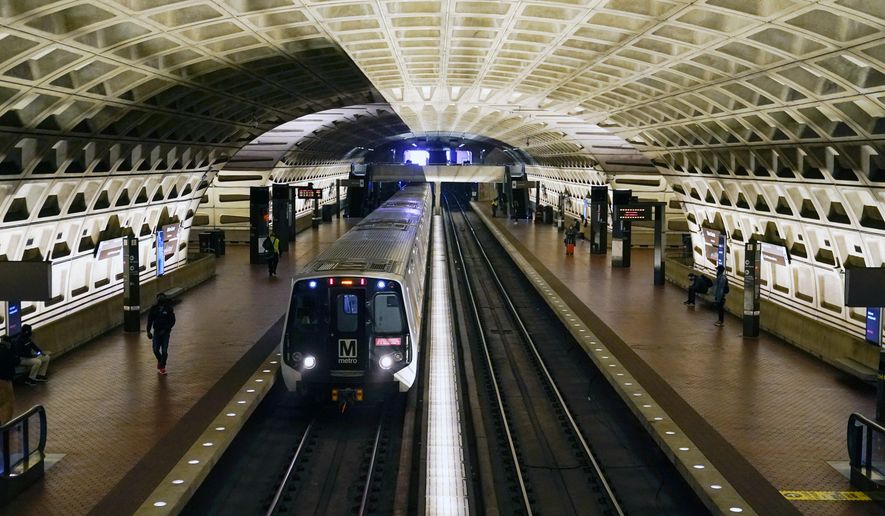The National Transportation Safety Board on Monday blamed last week’s derailment of a Metro train on its wheel assembly, saying the faulty system is a recurring problem federal investigators have noted for years.
NTSB chair Jennifer Homendy noted during a press conference that the Blue Line train had lifted off the tracks twice the same day before the third and final derailment. The train’s wheels moved too far apart on their axles, an issue found in other 7000 Series railcars, she said.
Fortunately, there were no fatalities or serious injuries during any of these derailments, but the “potential for fatalities and serious injuries was significant,” Ms. Homendy said Monday at the agency’s headquarters in Washington.
“This could have resulted in a catastrophic event,” she added.
On Monday, Metro grounded all of its 7000-series railcars, almost 60% of its rail fleet, and ran only about 40 trains as investigators inspected the trains.
Metro officials had said Sunday that the transit system would offer a “basic service pattern” on all lines Monday, which would operate as six-car trains, departing stations about every 30 minutes.
Reduced Metrorail service is expected to last until at least Sunday as officials continue to investigate the Oct. 12 derailment. Starting Tuesday, trains will run every 15 minutes on the Red Line and every 30 minutes for all other lines, Metro officials said. Silver Line trains will only run between Wiehle-Reston East and Federal Center SW.
The Washington Metrorail Safety Commission said in an order Sunday that it found that the fourth axle of a 7000-series railcar on the Blue Line train was “out of compliance” with specifications for wheel and axle assembly.
The Blue Line train was carrying about 190 passengers when it derailed Oct. 12 in a tunnel between Rosslyn and Arlington National Cemetery.
One passenger was taken to a hospital with non-life-threatening injuries, said Ms. Homendy, noting the train had eight of the 7000-series railcars.
The train may have lifted off the tracks an unknown number of times before last week’s derailment, she added.
Metro said it had informed federal authorities of similar problems with the wheel assembly in 2017, but the issue seems to be occurring with more frequency since.
Preliminary inspections found there were two-wheel assembly failures in 2017, two in 2018, four in 2019, five in 2020 and 39 this year — a total of 52 failures so far. The reported failures increased from 18 to 39 after emergency inspections following last week’s Blue Line derailment.
The numbers are preliminary and could go up, Ms. Homendy said. She said NTSB is aware of 748 railcars that are part of the 7000-series, but only 514 railcars have been inspected so far.
Ms. Homendy noted that the 7000-series railcars were made by Kawasaki, adding that the NTSB might issue an “urgent recommendation” alerting transit agencies to check Kawasaki trains for wheel assembly issues similar to those discovered in the Blue Line derailment.
“We still have to determine whether other transit agencies are affected, but this is something that will be part of our investigations,” said Ms. Homendy.
Kawasaki makes railcar models for other transportation systems, including PATH in New Jersey, the New York City Metropolitan Transportation Authority and the Southeastern Pennsylvania Transportation Authority in greater Philadelphia, Bloomberg reported.
However, it’s unknown if there will be a similar safety issue with these other transit systems. The 7000-series railcars were made by Kawasaki to replace older Metro railcars.
The Washington Times has reached out to Kawasaki for comment.
Metro officials said they will not return their 7000-series railcars to service until they are inspected further and deemed safe.
“Safety remains Metro’s number one priority,” said Metro General Manager Paul J. Wiedefeld in a statement Monday. “I want to assure our customers that their safety is driving every decision being made. We apologize for the reduced service, and ask for our customers’ continued patience and support as we work to get Metro back to normal operations.”
Ms. Homendy commended the decision by the Metro safety panel to halt the use of the railcars.
Under the safety commission’s order, Metro will have to develop a plan to determine the cause of the wheel assembly issues and develop a plan to detect and prevent the problem before resuming service for the railcars.
Metro officials are encouraging customers to use Metrobus for traveling instead in the meantime.
• Shen Wu Tan can be reached at stan@washingtontimes.com.




Please read our comment policy before commenting.